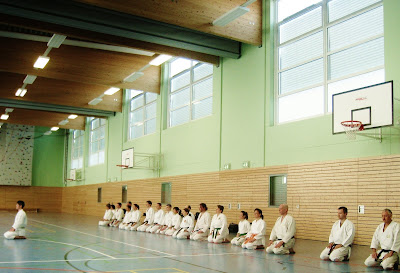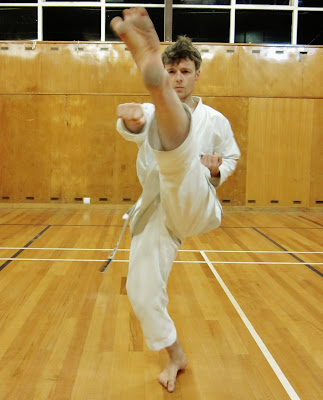
Recently I've posted several videos. Here is one with a brief profile, a handful of photos and some video footage.
© André Bertel. Christchurch, New Zealand (2011).
This site is based on my daily practice of Shotokan Karate-Do here in Oita City, Japan. More than anything else, unlike the majority of other karate websites, this page is primarily dedicated to Budo Karate training itself; that is, Karate-Do as a vehicle for holistic development.

 A quick link to the homepage of Sensei Lyall Stone's dojo, the CHRISTCHURCH SHOTOKAN KARATE CLUB (IJKA New Zealand Honbu Dojo) based at the CPIT Gymnasium in central Christchurch City. Several video links from this site have been featured: http://christchurchshotokan.blogspot.com/2011/06/style-of-christchurch-shotokan-karate.html
A quick link to the homepage of Sensei Lyall Stone's dojo, the CHRISTCHURCH SHOTOKAN KARATE CLUB (IJKA New Zealand Honbu Dojo) based at the CPIT Gymnasium in central Christchurch City. Several video links from this site have been featured: http://christchurchshotokan.blogspot.com/2011/06/style-of-christchurch-shotokan-karate.html Today is the fourth anniversary of this website (here’s a link to the post I made earlier today about this: http://andrebertel.blogspot.com/2011/06/4th-anniversary-of-andre-bertels-karate.html).
Today is the fourth anniversary of this website (here’s a link to the post I made earlier today about this: http://andrebertel.blogspot.com/2011/06/4th-anniversary-of-andre-bertels-karate.html). Today marks four years since I created this website and made my very first post: http://andrebertel.blogspot.com/2007/06/back-in-japan.html And if you've been
Today marks four years since I created this website and made my very first post: http://andrebertel.blogspot.com/2007/06/back-in-japan.html And if you've been  following the site, you will know that the objectives stated in that initial post have remained unchanged.
following the site, you will know that the objectives stated in that initial post have remained unchanged. Have browse through, and feel free to make some comments!
Have browse through, and feel free to make some comments! ech Republic, Denmark, Dominican Republic, El Salvador, Estonia, Finland, France, Georgia, Germany, Ghana, Greece, Guatemala, Honduras, Hungary, Iceland, India, Indonesia, Ireland, Israel, Italy, Japan, Jamaica, Kiribati, , Latvia, Lithuania, Malaysia, Mali, Malta, Mexico, Micronesia, Mongolia, Namibia, The Netherlands, New Zealand, Nicaragua, Norway, Peru, Philippines, Poland, Portugal, Romania, Singapore, Slovakia, Slovenia, South Africa, South Korea, Spain, Sweden, Thailand, Taiwan, Tonga, Trinidad and Tobago, Tuvalu, Ukraine, United Kingdom, United States of America and Uruguay. This is a real honour for me, and keeping in mind the mission statement of the site, I hope it has enlightened you all in regards to Asai-ha Shotokan-ryu Karatedo. Once again I offer my deepest thanks to everyone who have visited 'Andre Bertel's Karate-Do' and especially to those who have sent me personal messages. ARIGATO!
ech Republic, Denmark, Dominican Republic, El Salvador, Estonia, Finland, France, Georgia, Germany, Ghana, Greece, Guatemala, Honduras, Hungary, Iceland, India, Indonesia, Ireland, Israel, Italy, Japan, Jamaica, Kiribati, , Latvia, Lithuania, Malaysia, Mali, Malta, Mexico, Micronesia, Mongolia, Namibia, The Netherlands, New Zealand, Nicaragua, Norway, Peru, Philippines, Poland, Portugal, Romania, Singapore, Slovakia, Slovenia, South Africa, South Korea, Spain, Sweden, Thailand, Taiwan, Tonga, Trinidad and Tobago, Tuvalu, Ukraine, United Kingdom, United States of America and Uruguay. This is a real honour for me, and keeping in mind the mission statement of the site, I hope it has enlightened you all in regards to Asai-ha Shotokan-ryu Karatedo. Once again I offer my deepest thanks to everyone who have visited 'Andre Bertel's Karate-Do' and especially to those who have sent me personal messages. ARIGATO!
 We use five Heian and Junro kata side-by-side to acquire and achieve superior foundational techniques, and physical understanding of bujutsu (martial arts) karate. The difference between these two series’ of kata is best illustrated by the most common basic karatedo manoeuvres such as gedan-barai (‘lower level sweep’) which not coincidentally is the first technique of both Heian-shodan and Junro-shodan.
We use five Heian and Junro kata side-by-side to acquire and achieve superior foundational techniques, and physical understanding of bujutsu (martial arts) karate. The difference between these two series’ of kata is best illustrated by the most common basic karatedo manoeuvres such as gedan-barai (‘lower level sweep’) which not coincidentally is the first technique of both Heian-shodan and Junro-shodan. Junro-shodan the movement is more natural as it is a single arm gedan-barai as if reactively defending in kumite. In this case the hiki-te functions as merely a method of application and physical awareness as opposed to being used to ‘help’ with the body action. Power is instead derived from natural energy by (a) dropping the weight naturally down into kiba-dachi; and (b) use of a whipping action, in particular, shoulder and elbow snap.
Junro-shodan the movement is more natural as it is a single arm gedan-barai as if reactively defending in kumite. In this case the hiki-te functions as merely a method of application and physical awareness as opposed to being used to ‘help’ with the body action. Power is instead derived from natural energy by (a) dropping the weight naturally down into kiba-dachi; and (b) use of a whipping action, in particular, shoulder and elbow snap. away that I would continue practicing and teaching karate his way, and that starts with the IJKA versions of the five Junro kata.
away that I would continue practicing and teaching karate his way, and that starts with the IJKA versions of the five Junro kata. Everyone knows that one of Tetsuhiko Asai Sensei's trademark skills was his uncanny ability to "go in" ducking under his opponents attacks and deliver an unpredictable retaliation. This video features the first two basic/introductory IJKA Asai-ha Shotokan-ryu ducking drills. These practice: (1) Ducking under jodan gyaku-zuki (upper level reverse punch); and (2) Ducking under jodan huri-uchi (upper level swinging strikes).
Everyone knows that one of Tetsuhiko Asai Sensei's trademark skills was his uncanny ability to "go in" ducking under his opponents attacks and deliver an unpredictable retaliation. This video features the first two basic/introductory IJKA Asai-ha Shotokan-ryu ducking drills. These practice: (1) Ducking under jodan gyaku-zuki (upper level reverse punch); and (2) Ducking under jodan huri-uchi (upper level swinging strikes).© André Bertel. Christchurch, New Zealand (2011).

 The zone of proximal development was one of Russian scientist Lev Vygotsky’s most important contributions to the field of developmental psychology. It is defined by the void between what a person can independently do and what they can only do with assistance (Kail, 2010). A basic example might be when a karate instructor positions a beginner student into an exact zenkutsu-dachi (front stance), however when by themselves the individual cannot make the stance. For example their stance is say, too narrow, or has incorrect distribution of weight. Of course this not limited to single movements and positions but also renzokuwaza (combination techniques), kata, kumite (sparring) etc.
The zone of proximal development was one of Russian scientist Lev Vygotsky’s most important contributions to the field of developmental psychology. It is defined by the void between what a person can independently do and what they can only do with assistance (Kail, 2010). A basic example might be when a karate instructor positions a beginner student into an exact zenkutsu-dachi (front stance), however when by themselves the individual cannot make the stance. For example their stance is say, too narrow, or has incorrect distribution of weight. Of course this not limited to single movements and positions but also renzokuwaza (combination techniques), kata, kumite (sparring) etc. Kail, R.V. (2010). Children and their development (5th ed.). Pearson Education, Inc., Upper Saddle River, New Jersy. USA.
Kail, R.V. (2010). Children and their development (5th ed.). Pearson Education, Inc., Upper Saddle River, New Jersy. USA. Again by request, here are some of my Youtube video links including competition, seminars around the world, training etc. Kindest regards from Christchurch, New Zealand, Andre. http://andrebertel.blogspot.com/2011/01/andre-bertel-karate-do-video-links.html
Again by request, here are some of my Youtube video links including competition, seminars around the world, training etc. Kindest regards from Christchurch, New Zealand, Andre. http://andrebertel.blogspot.com/2011/01/andre-bertel-karate-do-video-links.html**************
FEBRUARY SEMINARS IN WESTERN AUSTRALIA: http://www.youtube.com/watch?v=kckvNnOa8Sk
JANUARY SEMINAR IN CHRISTCHURCH, NEW ZEALAND (Begins with a slow rendition of Kakuyoku-Nidan Kata): http://www.youtube.com/watch?v=m34qsesUDEQ
VIDEO FOOTAGE FROM EARLY LAST DECADE: http://andrebertel.blogspot.com/2011/02/new-video-andre-bertel-ijka-jks-new.html
ASSISTING ASAI SENSEI TEACHING IN HAWAII, U.S.A: http://andrebertel.blogspot.com/2011/02/new-video-assisting-asai-sensei-in.html
© André Bertel, Christchurch, New Zealand 2011.
 My two hour self-training yesterday consisted of only two techniques in ido-kihon; oi-zuki (chasing punch) and mae-geri (front snap kick). These were practiced individually then in combination with a mix of chudan/middle-level and jodan/upper-level targets
My two hour self-training yesterday consisted of only two techniques in ido-kihon; oi-zuki (chasing punch) and mae-geri (front snap kick). These were practiced individually then in combination with a mix of chudan/middle-level and jodan/upper-level targets  height, distance and movement alter where you aim your techniques).
height, distance and movement alter where you aim your techniques). People have emailed me wishing to access the official blog of the CHRISTCHURCH SHOTOKAN KARATE CLUB (I.J.K.A NEW ZEALAND). People who are seriously seeking to learn authentic Shotokan karate in Christchurch eventually find their way there. Here's the link: http://christchurchshotokan.blogspot.com/
People have emailed me wishing to access the official blog of the CHRISTCHURCH SHOTOKAN KARATE CLUB (I.J.K.A NEW ZEALAND). People who are seriously seeking to learn authentic Shotokan karate in Christchurch eventually find their way there. Here's the link: http://christchurchshotokan.blogspot.com/